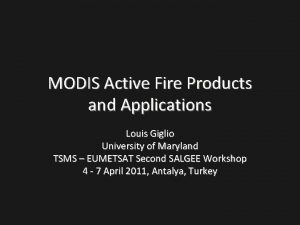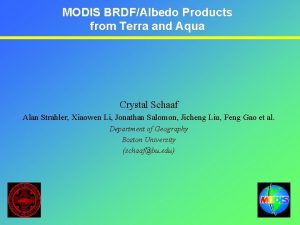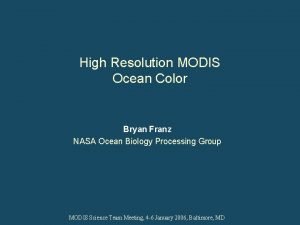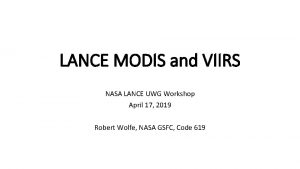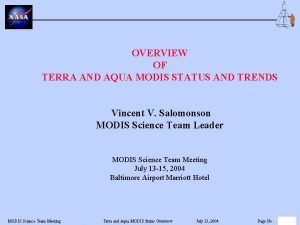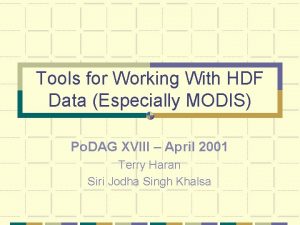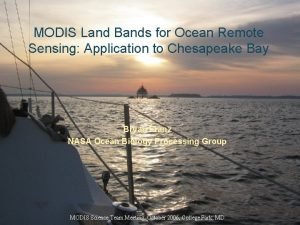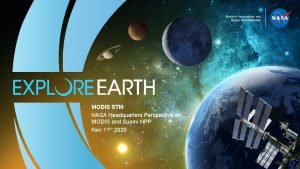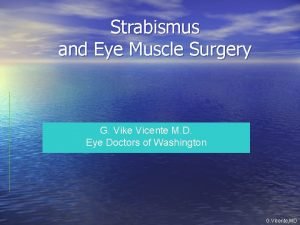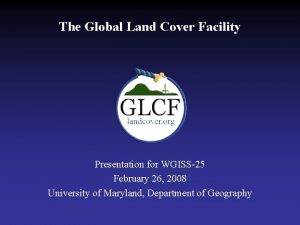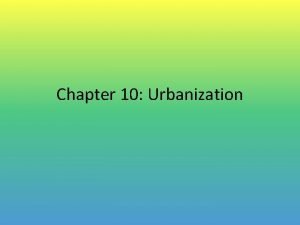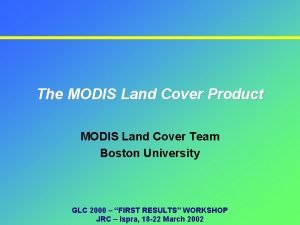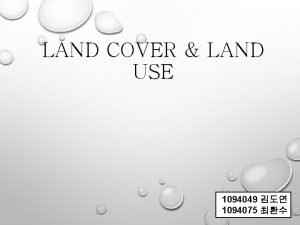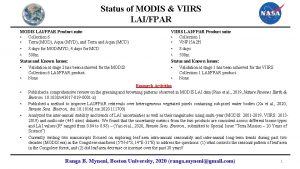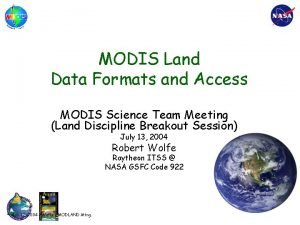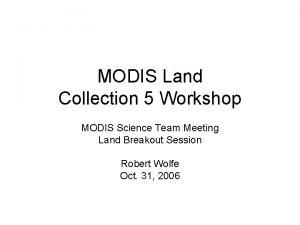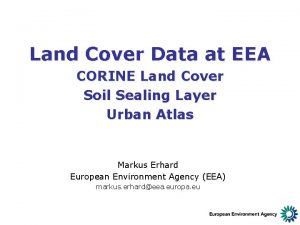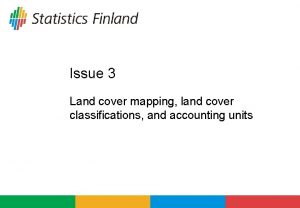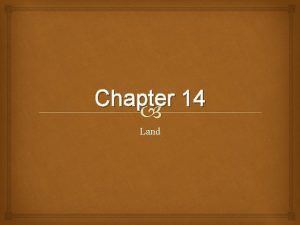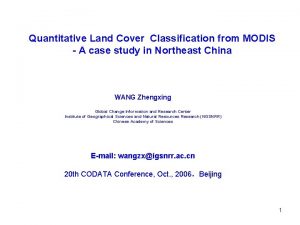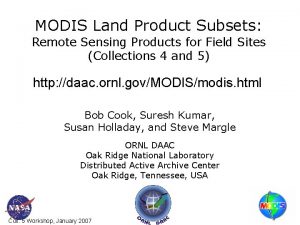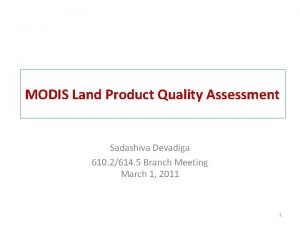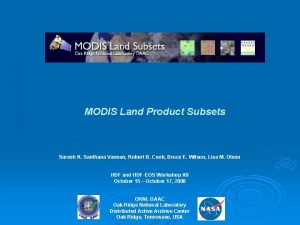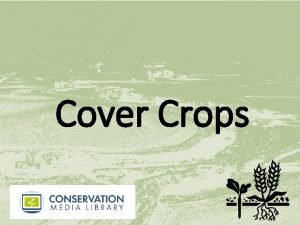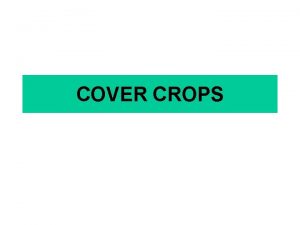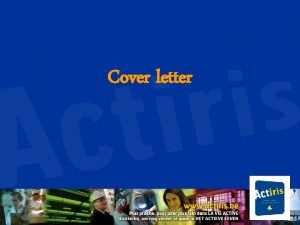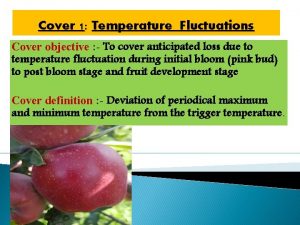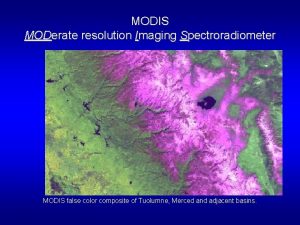The MODIS Land Cover Product MODIS Land Cover





























- Slides: 29

The MODIS Land Cover Product MODIS Land Cover Team Boston University GLC 2000 – “FIRST RESULTS” WORKSHOP JRC – Ispra, 18 -22 March 2002

Terra Launch on December 18, 1999

MODIS Land Bands

MODIS Land Cover Product • Objective: – Provide a simple land-cover categorization for biophysical parameterization for GCM, hydrologic, and carbon cycling models

MODIS Land Cover Product: Features – Categorizes land cover according to life-form, cover and height of dominant vegetation type following IGBP-DIS scheme – Uses data from spectral and temporal domains – Relies on advanced classifier technology—i. e. , decision trees—in a supervised classification mode – Network of global test sites used for algorithm calibration and validation – At-launch 1 -km database derived from AVHRR heritage – Level 3, 1 -km spatial resolution, 96 -day product; Climate Modeler’s Grid (1/4°) product

Recent Global Land Cover Products • Beta Product, released April 15, 2001 – Based on 2 16 -day periods of Normalized BRDF-Adjusted Reflectance (NBARs) • Provisional Product 2001001, released June 15, 2001 – Based on 9 16 -day periods of NBARs within July 11– January 15, 2001 – Uses prior probabilities to help separate agriculture and natural vegetation – Includes IGBP classification, secondary classes, confidence measures – Draws from at-launch product when only 0– 2 views are available or when classification confidence is less than 40%

Recent Global Land Cover Products, Cont. • Validated Product – Due 15 April 2002 – Based on MODIS data from 2001 – Includes 4 sets of labels, per-pixel confidence measures, second choices

IGBP Land Cover Units (17) • Natural Vegetation (11) – Evergreen Needleleaf Forests – Evergreen Broadleaf Forests – Deciduous Needleleaf Forests – Deciduous Broadleaf Forests – Mixed Forests – Closed Shrublands – Open Shrublands – Woody Savannas – Grasslands – Permanent Wetlands • Developed and Mosaic Lands (3) – Croplands – Urban and Built-Up Lands – Cropland/Natural Vegetation Mosaics • Nonvegetated Lands (3) – Snow and Ice – Barren – Water Bodies

The Land Cover Input Database • Surface Reflectance – Nadir-adjusted surface reflectance, 7 land bands • Vegetation Index – MODIS Vegetation Index, maximum value composite • Spatial Texture from 250 -m Band 2* – Standard deviation-tomean ratio in Band 2 (near -infrared), maximum value composite in 32 -day period *To be added later • Snow Cover* – MODIS Snow Cover Product, number of days with snow cover • Land Surface Temperature* – MODIS Land Surface Temperature, maximum value composite • Directional Information* – Bidirectional reflectance model choices from BRDF product • Ancillary Data – DEM, * Land/Water mask

Global Composite Map of Nadir BRDF-Adjusted Reflectance (NBAR) April 7– 22 2001 no data No data True color, MODIS Bands 2, 4, 3 10 km resolution, Hammer-Aitoff projection, produced by MODIS BRDF/Albedo Team MODLAND/Strahler et al.

MODIS Nadir BRDF-Adjusted Reflectance May 25–June 9 2001 False Color Image NIR–Red–Green

NBAR Time Trajectories

MODIS 500 m Vegetation Indices (September 30 – October 15, 2000 NDVI MOD 13 A 1 16 day Composite EVI MODLAND/Huete et al

Test Sites • IGBP-DIS Core/Confidence Sites – Random stratified sampling of classes on 1992 -93 IGBP Global Land Cover Product – 425 sites identified; 413 SPOT and TM scenes acquired; 91% migrated to WWW by BU • BU STEP Database – 2614 training sites from 645 TM scenes (6/6/00) – About 1000 training sites in current use for supervised classification

DISCover Core Validation Sites

Supplemental BU Training Sites

STEP Database • STEP: – System for Terrestrial Ecosystem Parameterization • Key STEP Parameters – Life form, height, cover fraction, of layers – Leaf type, phenology, periodicity, physiognomy of dominants in layers – Elevation, moisture regime, perturbation – Classifications: IGBP, BU, EDC SLCRs – Simple description of site and type (words) • STEP Flexibility – Allows application of many different land cover labeling schemes by inference of label from parameters in database

MODLand Support Products • Six Biomes for LAI / FPAR Algorithm – Used by Ranga Myneni’s radiative transfer model in retrieving LAI and FPAR • Six Biomes for Net Primary Productivity (NPP) – Used by Steve Running’s Biome-BGC model in making the MODIS NPP product • Fourteen Classes—University of Maryland Legend – We also provide a 14 -class product using the University of Maryland scheme – Preferred by some modelers

Provisional Land Cover Product June 01

Northeast Provisional Land Cover Product, Jul 00–Jan 01 Evergreen Needleleaf Forest Agriculture Mixed Forest Agriculture/Natural Vegetation Mosaic Urban Deciduous Broadleaf Forest

Classification Confidence Map Second Most-Likely Class

Land Cover Validation • Statistical Assessment Based on Site Data – Cross-validation provides probability estimate for errors of omission/commission • Two sets of site data: – DISCover Core/Confidence sites—Random stratified sample based on DISCover Land Cover map (Loveland et al. , EDC) – Supplemental sites compiled at BU—no explicit sampling design, but large N

Validation: Accuracy Assessment • Classification Accuracy from Cross. Validation of Training Sites – Hide 20 percent of training sites, classify with remaining 80 percent; repeat five times for five unique sets of all sites – Provides “confusion matrix” – Not a stratified random sample, but a good within-class indication of accuracy

Confusion Matrix Global Test Site Confusion Matrix—Provisional Product

Per-Pixel Confidence Output • Per-pixel Confidence – Based on statistical “boosting” theory – Allows decision-tree classifier to estimate probability of classification associated with each possible class label – Output for label with highest probability for each pixel

Validation: Other Datasets • Comparison with Community Benchmark Datasets – Global (e. g. , DISCover, UMd from AVHRR) • Comparison with independent maps derived from high resolution data, e. g. , – Humid Tropics: Landsat Pathfinder – Forest Cover: FAO Forest Resources Assessment – Western Europe: CORINE – United States: USGS/EPA MLRC – United States: California Timber Maps (Mc. Iver and Woodcock)

Validation: Comparisons • Collaborative Comparisons – Big. Foot sites – MODLand Test Sites

Big. Foot Results Reprojection of Big. Foot UTM maps to ISIN

Conclusions • MODIS Land Cover Product – – Draws on AVHRR heritage Utilizes improved data and techniques Top-down, globally-consistent approach Validation plan emphasizes multiple approaches to build confidence – “Validated” product to be released about 15 April 2002 based on 2001 data
 Modis
Modis Modis competence center
Modis competence center Modis
Modis Lance modis
Lance modis Aqua terra modis
Aqua terra modis Hdf tools
Hdf tools Modis bands
Modis bands Modis hq
Modis hq Hirschburg test
Hirschburg test Cover uncover test vs alternating cover test
Cover uncover test vs alternating cover test Worth four dot test
Worth four dot test Global land cover facility
Global land cover facility Uncentered commercial (strip) development
Uncentered commercial (strip) development What are landforms
What are landforms Identify the landform
Identify the landform Thế nào là số nguyên tố
Thế nào là số nguyên tố Tư thế ngồi viết
Tư thế ngồi viết đặc điểm cơ thể của người tối cổ
đặc điểm cơ thể của người tối cổ Mật thư anh em như thể tay chân
Mật thư anh em như thể tay chân Các châu lục và đại dương trên thế giới
Các châu lục và đại dương trên thế giới Tư thế worm breton
Tư thế worm breton ưu thế lai là gì
ưu thế lai là gì Thẻ vin
Thẻ vin Cái miệng xinh xinh thế chỉ nói điều hay thôi
Cái miệng xinh xinh thế chỉ nói điều hay thôi Các châu lục và đại dương trên thế giới
Các châu lục và đại dương trên thế giới Bổ thể
Bổ thể Từ ngữ thể hiện lòng nhân hậu
Từ ngữ thể hiện lòng nhân hậu Tư thế ngồi viết
Tư thế ngồi viết V cc
V cc Thể thơ truyền thống
Thể thơ truyền thống
